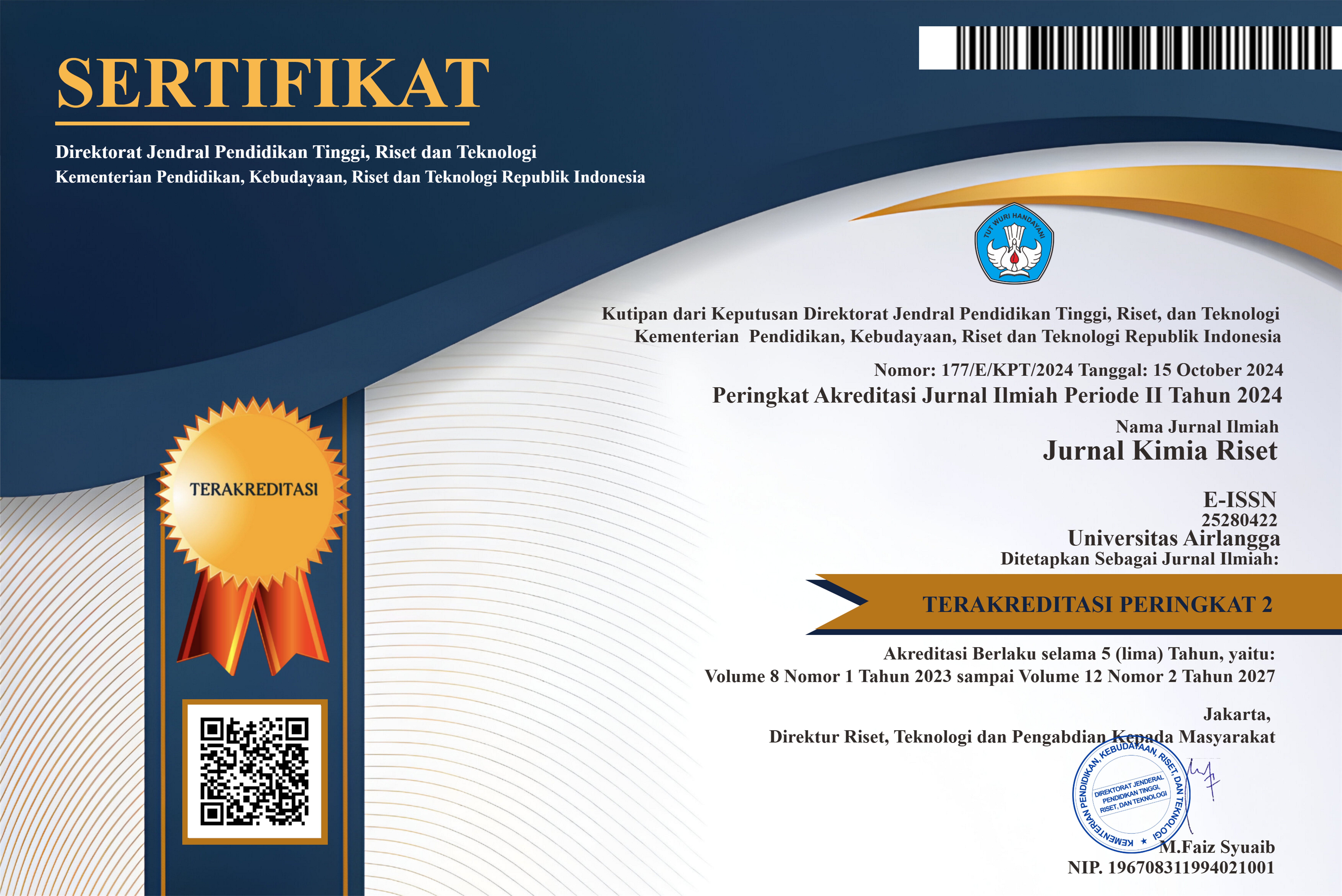Molecular Docking Study of Bioactive Compounds in Senggugu (Clerodendrum serratum (L.) Moon) as Antidiabetics
Downloads
Senggugu has the potential to be a source of natural medicine through its compounds. Using in silico approaches is an effective strategy for exploring compounds from natural products in the screening process. In vivo studies on senggugu have indicated that the plant has antidiabetic activity, although the active compounds involved in this activity are unknown. This study aims to explore the content of bioactive compounds of Senggugu (Clerodendrum serratum (L.) Moon) and its mechanism of action as an antidiabetic in silico with Molegro Virtual Docker software, ChemDraw, visualization with Discovery Studio, and ADMET prediction with pkCSM. The study was conducted by simulating the molecular docking of 31 bioactive compounds in Senggugu (Clerodendrum serratum (L.) Moon) with comparison compounds using glibenclamide, miglitol, rosiglitazone, linagliptin, and empagliflozin. The validated target proteins comprised 5 (five) receptors with PDB ID codes 4YVP, 5NN6, 7AWC, 6Y0F, and 7VSI. Based on this study, the compound predicted to be active as an antidiabetic is [(1S,2S,6R,7S,11R)-11-hydroxy-5,9,13-trimethylidene-4-oxo-3,14-dioxatricyclo [9.2.1.02,6] tetradecan-7-yl]2-methylprop-2-enoate at receptor 4YVP with a rerank score of -107.663 kcal/mol with glibenclamide -94.8299 kcal/mol and [3-hydroxy-4-[(2R)-6-methylhept-5-en-2yl]phenyl]methyl3-methylbut-2-enoate at 5NN6 receptor with a rerank score of -87.8719 with miglitol -64.7212 kcal/mol.
Abdullah, S. S., Putra, P. P., Antasionasti, I., Rundengan, G., Suoth, E. J., Abdullah, R. P. I., & Abdullah, F. (2021). Analisis Sifat Fisikokimia, Farmakokinetik Dan Toksikologi Pada Pericarpium Pala (Myristica Fragransa) Secara Artificial Intelligence. Chemistry Progress, 14(2), 81. https://doi.org/10.35799/cp.14.2.2021.37112
Az-Zahra, F., Afidika, J., Diamantha, S. D. A., Rahmani, A. E., Fatimah, S., Aulifa, D. L., Elaine, A. A., & Sitinjak, B. D. P. (2022). Studi In Silico Senyawa dalam Daun Sirih (Piper betle L.) sebagai Inhibitor Enzim Asetilkolinesterase (AChE) pada Penyakit Alzheimer. Indonesian Journal of Biological Pharmacy, 2(2), 44. https://doi.org/10.24198/ijbp.v2i2.40462
Hardjono, S. (2017). Prediksi Sifat Farmakokinetik, Toksisitas dan Aktivitas Sitotoksik Turunan N-Benzoil-N’-(4-fluorofenil) tiourea sebagai Calon Obat Antikanker melalui Pemodelan Molekul. Jurnal Ilmu Kefarmasian Indonesia, 14(2), 246–255.
Herdini, H. (2023). Studi In Silico: Senyawa Aktif Akar Senggugu (Clerodendrum serratum) terhadap Penghambatan Reseptor Human Chitotriosidase-1 (hCHIT1) sebagai Antiasma. Sainstech: Jurnal Penelitian Dan Pengkajian Sains Dan Teknologi, 33(2), 91–107. https://doi.org/10.37277/stch.v33i2.1717
Kadry, H., Noorani, B., & Cucullo, L. (2020). A blood–brain barrier overview on structure, function, impairment, and biomarkers of integrity. Fluids and Barriers of the CNS, 17(1), 69. https://doi.org/10.1186/s12987-020-00230-3
Kar, M. K., Trupti, S., & Mishra, S. K. (2014). Antidiabetic activity of Clerodendrum serratum (L.) moon leaves in streptozotocin-induced diabetic rats. Asian Journal of Pharmaceutical and Clinical Research, 7, 260–263.
Kemenkes, R. I. (2023). Ditjen P2P Laporan Kinerja Semester I Tahun 2023. Kemenkes RI, 1–134.
Leonita, E., & Muliani, A. (2015). Penggunaan Obat Tradisional oleh Penderita Diabetes Mellitus dan Faktor-faktor yang Berhubungan di Wilayah Kerja Puskesmas Rejosari Pekanbaru Tahun 2015. Jurnal Kesehatan Komunitas (Journal of Community Health), 3(1), 47–52. https://doi.org/10.25311/keskom.Vol3.Iss1.101
Lipinski, C. A. (2004). Lead- and drug-like compounds: the rule-of-five revolution. Drug Discovery Today: Technologies, 1(4), 337–341. https://doi.org/10.1016/j.ddtec.2004.11.007
Mulatsari, E., Martati, T., Mumpuni, E., & Dewi, N. L. (2020). In Silico Analysis of Antiviral Activity of Analog Curcumin Compounds. Jurnal Jamu Indonesia, 5(3), 114–121. https://doi.org/10.29244/jji.v5i3.173
Mumpuni, E., Mulatsari, E., & Noerfa, T. K. (2019). Skrining virtual dan elusidasi moda ikatan senyawa Inhibitor Enzim Elastase dan Hyaluronidase pada beberapa tanaman dengan aktivitas Anti-Aging. JFIOnline | Print ISSN 1412-1107 | e-ISSN 2355-696X, 11(2), 90–100. https://doi.org/10.35617/jfionline.v11i2.40
Prasetiyo, A., Martati, T., & Saputra, P. W. (2024). In Silico Study of Bioactive Compounds in Herba Sambiloto (Andrographis paniculata Burm. F. Nees) as HIV-1 Reverse Transcriptase Inhibitor. Jurnal Jamu Indonesia, 9(2). https://doi.org/10.29244/jji.v9i2.300
Prasetiyo, A., Mumpuni, E., & R. Tjandrawinata, R. (2019). Docking Molekular dari Trigonella foenum-graceum sebagai Antidiabetes menggunakan Molegro Virtual Docking. Jurnal Jamu Indonesia, 4(2), 74–80. https://doi.org/10.29244/jji.v4i2.132
Pratama, M. R. F., Poerwono, H., & Siswodiharjo, S. (2019). ADMET properties of novel 5-O-benzoylpinostrobin derivatives. Journal of Basic and Clinical Physiology and Pharmacology, 30(6). https://doi.org/10.1515/jbcpp-2019-0251
Saifuddin, A., Siswandono, & W., B. P. E. (2014). Studi In Silico Gendarusin A, B, C, D, Dan E Untuk Prediksi Absorbsi Dan Aktivitas Terhadap Hialuronidase (Ec 3.2.1.35). Jurnal Farmasi Dan Ilmu Kefarmasian Indonesia, Vol. 1(No. 2), 42–47.
Sari, I. W., Junaidin, J., & Pratiwi, D. (2020). Studi Molecular Docking Senyawa Flavonoid Herba Kumis Kucing (Orthosiphon stamineus B.) Pada Reseptor α-Glukosidase Sebagai Antidiabetes Tipe 2. Jurnal Farmagazine, 7(2), 54. https://doi.org/10.47653/farm.v7i2.194
Siswanto, I., Pranowo, H. D., & Mudasir, M. (2019). Docking of New Designed Compounds Derived from 1,6-Dihydro-1,3,5-triazine-2,4-diamine Toward Quadruple Mutant Plasmodium Dihydrofolate Reductase. Indonesian Journal of Chemistry, 19(3), 777. https://doi.org/10.22146/ijc.39943
Syarif, S. (2023). Studi In Silico Senyawa Aktif Kayu Jawa (Lannea Coromadelica) Sebagai Antiinflamasi Melalui Penghambatan Mediator TNF-α dan COX-2. Indonesian Journal of Pharmaceutical Science and Technology. https://doi.org/10.24198/ijpst.v0i0.46074
Wang, J.-H., Luan, F., He, X.-D., Wang, Y., & Li, M.-X. (2018). Traditional uses and pharmacological properties of Clerodendrum phytochemicals. Journal of Traditional and Complementary Medicine, 8(1), 24–38. https://doi.org/10.1016/j.jtcme.2017.04.001
Zahoor, T., Khan, S., Chinnam, S., Iqbal, T., Hussain, R., Khan, Y., Ullah, H., Daud, S., Rahman, R., Iqbal, R., Aljowaie, R. M., & Aghayeva, S. (2024). A combined in vitro and in silico approach of thiadiazole based Schiff base derivatives as multipotent inhibitor: Synthesis, spectral analysis, antidiabetic and antimicrobial activity. Results in Chemistry, 9, 101671. https://doi.org/10.1016/j.rechem.2024.101671
Copyright (c) 2025 Jurnal Kimia Riset

This work is licensed under a Creative Commons Attribution-NonCommercial-ShareAlike 4.0 International License.
COPYRIGHT NOTICE
1. By submitting the article to Jurnal Kimia Riset (JKR), the author has agreed to transfer some of the copyrights to the publisher of the research chemistry journal, Universitas Airlangga, indicated in the Copyright Transfer Agreement.
2. Authors still retain significant rights to use and share their own published articles for non-commercial purposes subject to Creative Commons Attribution-NonComercial 4.0 International License
3. All publications (printed/electronic) are open access for educational purposes, research, library, and other non-commercial purposes. Besides the purposes mentioned above, the editorial board is not responsible for copyright violations.















